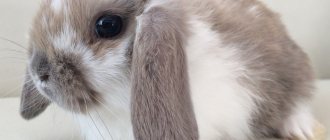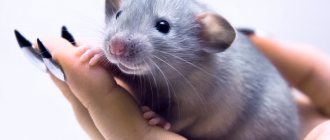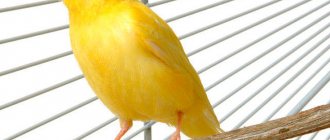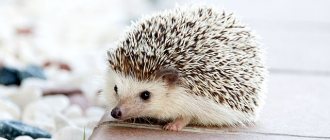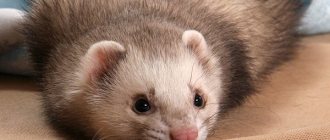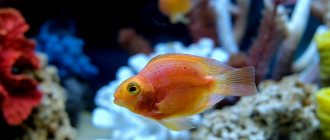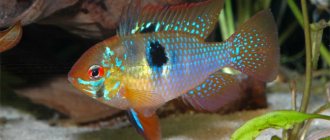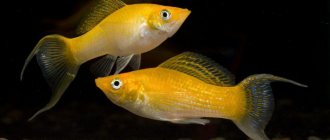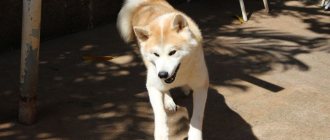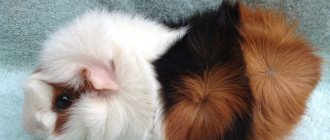Characteristics of the sugar glider
The sugar glider is a small animal that lives in the thicket of the eucalyptus forest. Outwardly, he looks like an ordinary squirrel. The animal belongs to the genus of marsupial sugar flying squirrels. The animal is also called the short-headed flying squirrel, pygmy flying squirrel, etc. In the wild, the possum is found in Australia, New Guinea and their neighboring islands.
Interesting! It was not by chance that the characteristic “sugar” was added to the name - the animal loves to feast on sweet food: pollen and nectar from flowers, fruit and tree sap.
Mammal dimensions:
- The body is up to 21 centimeters in length (the tail is not taken into account - it can reach the same length and is characterized by mobility);
- The weight of an adult possum is up to 160 grams.
Characteristics:
- Lifespan - in the wild they do not live longer than 8 years due to the danger of their habitat; at home they can live up to 12-15 years.
- Cost - in Russia, a flying squirrel can be found in pet stores or from breeders for 3-15 thousand rubles.
- The need for vaccinations - animals are not given any vaccinations, not excluding rabies injections (there is no need even for anthelmintics).
- Need for walks - the sugar glider depends on society and needs affection, communication and walks (if it is locked up for a long time, the animal will become lethargic, depressed and can take out aggression on the owner).
Population and species status
Environmental organizations have assigned this species the status of “Least Concern,” since this species is considered quite numerous within its natural habitat. These animals have maintained their numbers in nature due to a high degree of adaptation to various living conditions. If earlier flying squirrels preferred eucalyptus forests for their livelihoods, now they live in various types of forests. This is due to the fact that eucalyptus forests began to actively decline, which should have led to negative consequences in the life of these animals. Fortunately, these animals easily adapted to new habitat conditions, choosing different types of forest areas.
Nowadays, these animals are found wherever there is something to eat. Flying squirrels are found in both primary and secondary forests, including degraded forests, within various plantations and even in gardens. That is why sugar flying squirrels are not among the species that are threatened with complete extinction, especially in the near future.
Positive factors influencing the population size of these animals include their high endurance and sufficient life expectancy for such animals. Living in the wild, as well as in the presence of sufficient food, these small animals can live up to one and a half decades. Naturally, this attracts many who like to keep animals at home. These animals can delight others for many years, which is not possible for many decorative rodents.
In other words, the sugar glider is quite an attractive animal by many criteria. In addition to the fact that the animal has a unique appearance, it does not show aggression towards humans. This is why the flying squirrel is kept as a pet in many countries. Under natural conditions, this animal is found only in tropical conditions.
Behavior
Most of all, people are afraid that the animal will start biting - this is an unreasonable fear. The flying squirrel is not at all aggressive, but if it nevertheless begins to bite its owner, then there are always reasons for this:
- Shyness. This happens if the animal appeared in the house relatively recently and did not have time to adapt to the conditions. Or the owner disturbed a pregnant female, mother and cubs. In the first case, you should try to establish contact with the flying squirrel: sweeten it with a treat, while speaking in a calm and affectionate tone, try to caress it. In the second situation, it is better not to touch the animal at all. If the owner is afraid of being bitten, then you can wrap the hand with a rag or soft cloth.
- The possum tastes the owner or shows him its location - it’s not difficult to deal with it: put food on your hand so that the animal switches to it.
- The flying squirrel does not recognize the owner's scent or does not like the way it smells - the possum gets used to one distinct smell from a person, and when it changes, they stop recognizing the owner. It is recommended to stick to the same perfume and use the same soap. Another solution is to shower before interacting with the squirrel.
Another important aspect of behavior is receptivity to training. The flying squirrel can hardly be called a stupid animal, because it responds well to vocal intonation. A squirrel can easily be taught basic commands and come running when called.
The peculiarity of marsupial flying squirrels is barking at night. If this happens, then it's a matter of boredom. The squirrel calls its owner, especially if it is alone in the cage. It’s also about the mode of life - in the evening the mammal just begins to be active, and the person, most likely, is already preparing for bed. If possible, the animal should be petted and let out for a walk around the room. It wouldn’t hurt to buy him a friend and equip their home so that they have something to entertain themselves with.
Squirrels do not like cold conditions, so their activity decreases in rain or cold weather. They become lethargic and hibernate. This behavior in winter allows them to spend less energy when there are already problems with nutrition.
Feeding
The most important question that the happy owner of a sugar glider will have to face is what to feed the animal. Proper nutrition is the key not only to health, but, consequently, to a long and happy life. The smell and mood of your pet also depend on this.
In the wild, the sugar squirrel is an omnivore. The main part of its diet consists of fruits and insects. When feeding, you should adhere to the following principles and rules:
- The 70 to 30 rule – 70% of the diet is protein, the remaining 30% is carbohydrates.
- The feeders are filled with food and the drinking bowl with fresh water immediately before the flying squirrels wake up - at approximately 9 - 10 pm. In the morning, you need to clean the feeders and leave the water. If a possum has access to food 24 hours a day, it will suffer from obesity. Representatives of this subspecies are able to wake up in the daytime and sleepily drag a treat into the nest, falling asleep on the move, often with an unchewed piece of food in their paws. The maximum that can be left for the possum during the day is a piece of fruit or dried fruit, as well as a little juice diluted with water.
- If your pet doesn't drink for a long time, don't be alarmed. Sugar squirrels can get enough moisture from fruits. Despite this, water in the drinking bowl must be constantly present in the cage. It is better to use filtered or bottled water and change it at least once a day to prevent harmful bacteria from growing in it.
- Foods from the human table are prohibited for feeding: fatty, spicy, fried, salted, sausages, etc. The maximum that can be allowed is chicken or turkey meat, cooked without salt and spices.
- Sweets (honey, fruits) can be given to the animal in limited quantities - as a treat, to support the female during pregnancy and feeding the cubs.
- The food should contain as much calcium as possible (the domestic sugar glider is very sensitive to its deficiency) and as little phosphorus as possible.
- All vegetables and fruits should be cut into fairly large pieces that will be easy for the squirrels to pick up in their paws. The animal will not like small pieces.
We invite you to familiarize yourself with Asher: a large overview of the breed
https://www.youtube.com/watch?v=pXm9Q3-45HQ
Products necessary for the normal development of the dwarf flying squirrel:
Content
Keeping sugar squirrels at home is not easy and troublesome, but realistically it is the main desire. A person will have to follow the rules of life of the animal and care for it.
House maintenance (cons)
Flaws:
- The squirrel will not adapt to the routine of life in the house - it will continue to behave as it is used to in its environment. At night the animal does not like to sleep, but will start jumping around the cage, making noise or rattling everything. Therefore, for its maintenance it is recommended to allocate a separate room, which is located at a distance from the bedroom.
- These animals are not famous for cleanliness and go to the toilet wherever they have to. In nature, they jump through trees, practically without touching the ground - and urinate on the fly. At home, their behavior will not change: they will stain furniture, walls and even the owner with feces.
- The animal loves to mark its territory using secretions from the glands. They have a rather pungent smell - they practically do not wash off from clothes, you just have to get used to them.
- Children should not be allowed alone near possums. This can harm both the child and the animal. The squirrel will begin to bite if you hold it in your hand. The baby loves to run around the owner, as if through the branches of a tree, leaving deep scratches with his claws that take a long time to heal.
In wild nature
Possums live in small groups that can number up to 7 adults and babies of the current litter. There is one male - the dominant one, who marks his territory and the flock with the help of special glands. They will drive out alien squirrels with a different smell from their lands.
Under natural conditions, animals hunt spiders, insects, small birds and other small animals, as well as sweets - nectars, juices, etc.
Reproduction
Sugar gliders have a seasonal polyestrus (June to November in Australia), are polygamous animals, with young mostly born in the spring, which coincides with the presence of large numbers of insects. Litter size ranges from two (81%) to 1 (19%) young, although the female has four teats. Two litters are usually born in one mating season.
The estrous cycle is 29 days, and pregnancy is 15-17 days (Tyndale-Biscoe and Renfree, 1987). The weight of newborn cubs is 0.2 g, the female carries them in a pouch for 70-74 days. When the cubs become too large to fit in the pouch, they leave it, but remain in the nest (hollow) and suckle their mother until they are 110-120 days old.
To recognize the pathology of the reproductive system, you need to know its anatomy. Female flying sugar gliders have two uteri and two long, thin vaginas that open proximally into a central blind vaginal sac, separated by a septum. Both sexes have anterior dorsal and ventral paracloacal glands, which are better developed in males.
Care
Proper care will ensure a happy life and comfortable conditions for the possum. If you don't follow the rules, the animal will become depressed and aggressive.
Feeding
Health, and therefore the length of life and the mood of the animal, depend on proper nutrition. Diet affects smell and even aggressiveness.
Daily diet
The following rules will help you create a feeding plan:
- Fruits are the most important component in the flying squirrel’s diet; they should be about 70% of the total diet;
- The remaining 30% are protein components;
- It is recommended to minimize phosphorus concentrations and provide more calcium;
- Watch out for sweets - it should be a delicacy, not an everyday occurrence;
- It is allowed to diversify the food with meat (boiled turkey or chicken);
- Live food (insects) is also needed;
- Once every few days the possum is given honey - this affects its metabolism.
What is possible
Fruits and vegetables are cut into large pieces - this makes it easier to take the paws. The squirrel doesn't like small pieces.
Insects:
- Worms;
- Zoophobas;
- Banana crickets.
Dairy products:
- Cottage cheese;
- Kefir;
- Yogurt.
You can also give baby food, cereals and meat (chicken, turkey). These are all sources of protein. The diet should also contain carbohydrates - these are fruits (dried, pureed, etc.).
Nuts, honey, and drops are suitable as treats.
What not to do
Human and too fatty food is not suitable for the possum. More specifically, it is prohibited to give:
- Bird food;
- Grapes and raisins;
- Lettuce, cheese;
- Excessive amounts of nuts.
Housing
You need to understand whether you plan to buy one or two animals at once. If the owner does not have time to deal with the squirrel for several hours every day, then it is better to choose the second option. More often, possums of different sexes are purchased to form a pair.
The housing should be located in a slightly dark place, away from the bedroom - this will help to avoid sounds at night. The cage also needs to be protected from drafts, heat sources, direct rays of the sun, plants, furniture - everything that the squirrel can reach. Content temperature is from 20 to 30 degrees Celsius. The tray should contain wood filler to absorb the smell.
Fur and claw care
Although the flying squirrel is unclean, they take a little care of themselves - like cats, they lick themselves, cleaning their fur with their claws and tongue, so the owner does not have to painstakingly care for the fur.
Swimming is not permitted. The squirrel is not afraid of water, but is not adapted to swimming and, without proper supervision, can drown even in a small basin or jar. If it happens that the baby gets very dirty with something, you need to carefully wipe him with a damp cloth or cotton towel soaked in boiled water. After completing the procedure, the animal must be dried completely and avoid being in a cool room or in a draft.
Sometimes owners leave a sand bath in the cage for bathing - but this is not necessary. Squirrels don't even climb there.
The animal sharpens its claws on its own - on imitation wooden branches that should be in the cage. If for some reason they have grown too much, they will still have to be cut off using a nail clipper (like for cats or dogs).
Veterinary
Manipulation and fixation If you need to catch a possum, then close the exit from the nest box, and then remove or open the lid and take the animal with a hand dressed in a small cotton bag, which is then turned inside out on top of the possum.
All seams must be double so that the possum does not get entangled in protruding threads or frayed holes. Sedation and anesthesia Tilagamine-zolazepam at a dose of 10 mg/kg IM caused death in three apparently healthy flying possums. Therefore, this drug combination is not recommended for sugar gliders, although it has been shown to be effective and safe for other glider species. Isoflurane is given with oxygen through a vaporizer and T-tube.
Anesthesia (5% isoflurane) is given through a small mask. Intubation is carried out through a tube with a diameter of 1 mm and a probe (Cook). The tongue is removed, and to examine the pharynx, a thin laryngoscope is used, which is used to lift the soft palate as much as possible. Anesthesia is maintained with 2% isoflurane. Table 5 shows the physiological parameters (body temperature, heart rate and respiratory movements) of the animal under isoflurane anesthesia.
Taking blood To take blood, you need general anesthesia. A volume of blood equal to 1% of the body vega can be taken from possums. Medial tibial artery. This superficial artery runs medially from the knee to the tarsus. Blood can be drawn from this artery with a tuberculin syringe and a 29G needle. The artery is very mobile, so it is better to enter it distal to the knee.
Jugular vein. It is difficult to visualize the jugular vein because gliders have a short, folded neck and a lot of subcutaneous fatty tissue. Remove fur. The entrance to the chest and the angle of the jaw are found to determine the direction of the jugular groove.
Lateral vein of the tail. This vein runs down each side of the tail. After removing the hair and applying a rubber tourniquet, this vein becomes visible and is punctured with a 25-gauge needle to obtain a drop of blood, which is collected in a hematocrit tube. Alcohol interferes with the formation of blood droplets on the surface of the skin due to a decrease in surface tension, so it is better to use an aqueous antiseptic.
Femoral vein. This location is not suitable for blood collection.
Taking blood from the heart. This procedure is carried out only in emergency situations.
Taking blood from the conjunctiva of the eye. It is not recommended to provoke bleeding from the conjunctiva of the eye in animals with exophthalmos.
Hematological and biochemical parameters are normal
Table 4 shows the physiological values of haematological and biochemical parameters of sugar gliders from South East Queensland.
| Table 4. Haematological and biochemical normal parameters in sugar gliders from South East Queensland | ||||
| Parameter | Units | № | Average value | Limits of change |
| Red blood cells | X 1012/l | 7 | 7,5 | 6,5-8,3 |
| Hemoglobin | g/l | 7 | 151 | 128-162 |
| Hematocrit | % | 7 | 47,6 | 40-51 |
| Average cellular hemoglobin | µl | 7 | 20,2 | 18,5-21,9 |
| Average cellular hemoglobin concentration | g/l | 7 | 318 | 310-338 |
| Average cell volume | fl | 7 | 63,7 | 57,8-69,6 |
| Leukocytes | X 109/l | 7 | 16,3 | 9,1-22,8 |
| Segmented nuclear neutrophils | X 109/l | 7 | 1,01 | 0,45-1,75 |
| Lymphocytes | X 109/l | 7 | 14,99 | 8,28-21,2 |
| Monocytes | X 109/l | 7 | 0,05 | 0-0,23 |
| Eosinophils | X 109/l | 7 | 0,23 | 0-0,99 |
| Basophils | X 109/l | 7 | ||
| Glucose | mmol/l | 2 | 4,0 | 1,1-6,88 |
| Urea | mmol/l | 7 | 6,39 | 3,61-9,71 |
| Creatinine | mmol/l | 5 | 48,0 | 20-70 |
| Calcium | mmol/l | 1 | 2,4 | 2,4 |
| Phosphorus | mmol/l | 1 | 2,6 | 2,6 |
| Sodium | mmol/l | 5 | 144,2 | 138-158 |
| Potassium | mmol/l | 3 | 5,4 | 4,4-6,3 |
| Chlorides | mmol/l | 5 | 105,2 | 101-109 |
| Bicarbonate | mmol/l | 2 | 21,1 | 20,8-21,3 |
| Cholesterol | mmol/l | 3 | 5,17 | 3,3-6,4 |
| Total protein | g/l | 6 | 62,5 | 56-69 |
| Albumin | g/l | 6 | 33,3 | 30-35 |
| Globulins | g/l | 6 | 29,2 | 22-36 |
| Alanine aminotransferase | E/l | 3 | 36 | 28-44 |
| Alkaline phosphatase | E/l | 1 | 188 | 188 |
| Aspartate aminotransferase | E/l | 3 | 49,7 | 20-70 |
| Creatinine phosphokinase | E/l | 1 | 224 | 224 |
These values differ from the International Species Inventory System (ISIS) database obtained in captivity from more than 17 animals in North America - Queensland gliders have a much higher number of lymphocytes. The significance of this finding is not yet clear; it may be the result of population genetic variations, or it may reflect a difference between arterial and venous blood.
| Table 5. Selected physiological parameters of sugar gliders from South East Kansasland | |
| Parameter | Normal/average values |
| Heart rate | 200-300 per minute* |
| Respiratory rate | 16-40 per minute |
| Body temperature* | 36.3 -s |
| Body temperature during hibernation** | greater than or equal to 15 'C |
| Thermoneutral zone** | 27-31 'C |
| Minimum metabolic rate** | 2.54 W kg075 |
| •Under isoflurane anesthesia. **Fleming MR: Themoregulation and torpor. | |
Common diseasesHelminths. There were no reports of diseases caused by helminths. In sugar gliders, trematodes of the species Athesmia were found in the liver, and nematodes of the species Parastrongyloides and Paraustrostrongylus Paraustroxyuris were found in the intestines (Spratte et al., 1991). Ectoparasites of sugar gliders include mites of Guntheriakowanyama, Petauralgesrackae, and Atopomeliae species.
The following anthelmintic drugs can be used for possums without visible side effects: fenbendazole at a dose of 20-50 mg/kg po once a day for 3 days, oxfendazole at 5 mg/kg po only once and ivermectin 0.2 mg/kg p/o or sc only 1 time. Carbaryl powder (50 g/kg) is used topically to treat the nest box to prevent the development of mites.
READ Oriole: photo of the oriole and description of the bird. Where does the oriole live and what does it eat?
Infectious diseases. Sugar gliders have been noted to be insensitive to common infectious pathogens, but there are certain microorganisms to which gliders have been shown to be predisposed: Cryptococcus neoformas, Yersiniapseudotuberculosis, Salmonella spp., Mycobacterium, Toxoplasmagondii spp., and Leptospira spp. Bacterial meningitis killed 2 of 14 (14%) gliders at one research institute. The microorganism has not been identified.
Non-communicable diseases. Feeding osteodystrophy or pelvic limb paresis is a common disease of domestic sugar gliders, but has never been observed in zoological garden collections. Unpublished research suggests that this disease is very similar to feeding osteodystrophy, which is seen in calcium-deficient lizards.
The clinical manifestation is sudden paresis or paralysis of the pelvic limbs. X-rays show osteoporosis of the vertebrae, pelvis and long bones. The differential diagnosis of osteodystrophy is spinal injury. The diet of most gliders is potentially low in calcium - 75% fruit and 25% meat.
If diagnosed early, success can be achieved with a diet rich in calcium and vitamin D, as well as confined housing. Nocturnal animals are better able to absorb vitamin D3 in the intestines, rather than through exposure to ultraviolet rays, which convert vitamin D1 to D2. The diet should contain approximately 1% calcium, 0.5% phosphorus and 1500 IU/kg vitamin D3 based on the dry weight of the feed.
Calcium should also be added to the diet of insects given to gliders. It is better to feed gliders a high-calcium diet (Mazuri, PMIFeeds, St. Louis, MO) than to sprinkle calcium powder on the insects. Neoplasia. Neoplasia, especially lymphoid (50% of all recorded neoplasms), is often observed in possums in captivity.
A review of mortality among possums in one collection found that 3 of 14 flying squirrels (21%) died from neoplasia, one possum had malignant lymphoma of the spleen, liver, and kidneys, a second had a basal cell tumor of the bursa, and a third had bronchogenic carcinoma. Two of the three deaths of great gliders (Petauroidesvolans) were due to neoplasia, one had chondrosarcoma of the jaw with metastases to the liver, and the other had lymphosarcoma of the lymph nodes and spleen. A report of cutaneous lymphosarcoma in sugar gliders has also been published (Houghetal., 1992).
Severe allergic dermatitis. Severe allergic dermatitis was observed in flying squirrels after using shampoo with 1% selenium sulfide.
Obesity. In Leadbeater's possums, this condition is caused by fatal coronary atherosclerosis. Necropsy of an obese possum weighing 300 g at the age of 3.5 years revealed only necrosis of abdominal fat tissue.
Dental diseases. In captivity, possums often experience periodontal disease and plaque accumulation on their teeth, especially if the animals eat soft food high in carbohydrates. Removal of plaque under general anesthesia is indicated, and then the prescription of broad-spectrum antibiotics. Changes in the diet are also needed, in which you need to include as much animal food as possible, especially insects with hard exocelete.
After tooth decay or traumatic fractures and cracks of the incisors, the root canal may be exposed. The diameter of the root canal is very small for it to be filled with something, and it is almost impossible to remove the lower incisors without breaking the mandibular symphyses. Animals tolerate the opening of a root canal calmly, but choose soft food, therefore, it is necessary to monitor the formation of dental plaque.
Eye diseases. Sugar gliders have exophthalmos and often suffer corneal injuries during fights. Corneal ulcers are also common and respond well to treatment with temporal tarsorrhaphy and the application of antibacterial eye ointment. Bite wounds in the muzzle can lead to retrobulbar abscesses, which must be differentiated from root abscesses of molars.
Cell
For one individual you will need a cage with a tray, an aviary, a terrarium or a display case with dimensions of 50-50-80 cm, for two 140-50-80 cm. It is better to provide the largest possible conditions. If a cage is used as a container, the bars should not be narrower than 1 cm.
Reference cell
What should be in the cage
Be sure to have a drinking bowl and several feeders. It is important that the squirrel is habituated, otherwise it may die of thirst. Small metal or ceramic feeders are required.
Inside the cage you need climbing structures, a house, branches, pipes, etc.
What shouldn't happen
There should be no materials inside the cage that could poison the animal. Curiosity and constant contact can cause a squirrel to try something, which can affect its health.
Features of flying squirrels
- Sugar gliders are kind and affectionate animals.
- Animals can make various sounds similar to dog barking, whistling, and chirping.
- They are nocturnal and see well in the dark.
- Flying squirrels molt 2 times a year, and if the animal is not eating properly and is under stress, it may also experience hair loss.
- During flight, the animal is able to cover a distance of up to 50 meters, and use its legs and tail to change direction.
- Females have a pouch on their abdomen with four nipples inside.
- If the possum does not have enough food, it falls into a peculiar state similar to constant sleep and can remain like this for up to 24 hours.
- Males have a large number of glands on their body, with the help of which they secrete a special substance with a peculiar odor, reminiscent of musk, and mark their territory.
- Under natural conditions, sugar gliders live in groups with a predominance of females and a dominant male at the head.
- The lifespan of the animals is 4–7 years, in captivity up to 13 years.
We invite you to familiarize yourself with Domestic Dangers for Pets
Diseases
Possums suffer from a fair number of ailments that affect their lifespan. Most often they are affected by metabolic bone disease associated with injury and poor nutrition. Possible diarrhea from overloading the stomach with fruit or due to parasites. Any treatment is carried out under the supervision of a veterinarian.
Irina Ivanishchena
I am engaged in professional breeding of hamsters and rats on an ongoing basis. I know something about them that most people don’t know. Always open to constructive discussion
Post Views: 1,614
Accommodations
To live a full life at home, flying squirrels need a lot of space. It is worth remembering that these animals are quite active and live in trees in the wild.
Therefore, first of all, it is necessary to prepare a spacious cage for your pet, equipped with all the necessary equipment.
And we must also remember that possums are heat-loving animals, so their habitats should be warm, without drafts or too bright lighting.
The conditions of detention should be as follows:
- These exotic animals must live in large cages; those designed for keeping birds are quite suitable. Possums are quite active, so the cage should be high; its approximate dimensions for one animal to live in are: length and width - 50 cm, height - 80 cm.
- The cage should contain small houses that will serve as nests for the animals, made of wood, plywood or other dense material. They need to be hung at the top of the cage. At the bottom of the houses you need to put a soft bedding made of dense fabric.
- Be sure to place a piece of driftwood or several branches without bark in the cage so that it is convenient for the animals to climb on them and grind off their sharp claws. It is worth remembering that they need to be changed regularly.
- There should also be several firmly installed feeders and a drinking bowl made of metal or ceramics. It is best if all these attributes are firmly fixed to the walls so that the animals cannot turn them over. Make sure your glider knows how to use a water bottle.
- In order for flying squirrels not to get bored, there must be a wheel in the cage, without the presence of wire in its design. You can also place toys made of plastic and quite large in size; various balls, mice and balls intended for cats are very suitable for animals.
- You can build stairs, hammocks, ropes, and tunnels to entertain animals.
We invite you to familiarize yourself with Scottish Straight
